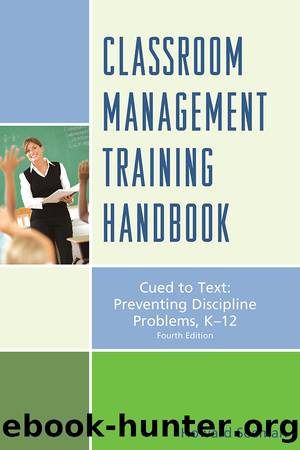Life and Death in the Garden by Meyer Kathryn;

Author:Meyer, Kathryn; [Seeman, Howard]
Language: eng
Format: epub
Publisher: Rowman & Littlefield Publishers
Published: 2014-08-15T00:00:00+00:00
Training Exercises
Exercise One: Rating Your Present Rules and Warnings
List here six or seven of the rules and warnings you are presently using in your classroom. In the column at the right, place the number of the guideline that is not being followed by you for the rule. (The guidelines are listed at the beginning of Chapter 12 in the text, section A.)
Rule
Guideline Not Followed
1.
2.
3.
4.
5.
6.
7.
Which rules are bad ones? Which guidelines do you tend not to heed?
Exercise Two: Not Giving Negative Attention
List your tendencies here where you tend to give negative attention:
1.
2.
3.
4.
5.
6.
Now, write down here three ways you can reprimand a student in a non-audience setting.
1.
2.
3.
Exercise Three: Deciding Your Limits
Have a friend, colleague, or classmate throw demand questions at you, such as: âCan I go to the bathroom during class?â âCan I go twice in one period?â âCan you lend me a dime?â âDo I have to do the homework?â âCan I call you by your first name?â Ask them to make all their questions answerable by either: âyes,â âno,â âmaybe,â or ânone of your business.â
You must answer each question as fast as you can, on the spot. However, if you take the easy road of âmaybe,â you must answer, âIf what?â You must state your conditions. Since teachers often canât give rationales, you canât justify your judgments. Just answer âyes,â âno,â âmaybeâ (if what?) or ânone of your business.â Do this exercise with your partner. Then reverse roles: let the other person be the teacher and you be the demanding, questioning student.
Where are you cloudy on your limits?
Do you say âyesâ more often than you mean because of fear of anger or of being disliked?
Could you follow through with your ânosâ? (Have your partner see if s/he can change your answer by acting angry, sad, seductive, etc.)
Exercise Four: Deciding Your Warning Steps and Consequences
Try to fill in the chart below by trying this ânightmare.â Assume that (in the left column) you are âteaching and all is going well,â and the students (in the right column 1) are all âpaying attention.â However, suddenly, in 2 âa student calls out.â What would you do at this time? Write your response in 2, the left column. Now assume that the student violates whatever warning (or whatever you did) in 2. Imagine what it is s/he does to violate you (write it out as 3 in the right column). Now, what do you do about this 3?
Download
This site does not store any files on its server. We only index and link to content provided by other sites. Please contact the content providers to delete copyright contents if any and email us, we'll remove relevant links or contents immediately.
| Central Asia | Southeast Asia |
| China | Hong Kong |
| India | Japan |
| Korea | Pakistan |
| Philippines | Russia |
The Rape of Nanking by Iris Chang(3522)
The Sympathizer by Viet Thanh Nguyen(3506)
World without end by Ken Follett(3010)
Ants Among Elephants by Sujatha Gidla(2927)
Blood and Sand by Alex Von Tunzelmann(2611)
Japanese Design by Patricia J. Graham(2560)
City of Djinns: a year in Delhi by William Dalrymple(2138)
Inglorious Empire by Shashi Tharoor(2103)
In Order to Live: A North Korean Girl's Journey to Freedom by Yeonmi Park(2061)
Foreign Devils on the Silk Road: The Search for the Lost Treasures of Central Asia by Peter Hopkirk(2058)
Tokyo by Rob Goss(2022)
India's biggest cover-up by Dhar Anuj(1988)
India's Ancient Past by R.S. Sharma(1988)
The Great Game: On Secret Service in High Asia by Peter Hopkirk(1962)
Tokyo Geek's Guide: Manga, Anime, Gaming, Cosplay, Toys, Idols & More - The Ultimate Guide to Japan's Otaku Culture by Simone Gianni(1949)
Goodbye Madame Butterfly(1938)
The Queen of Nothing by Holly Black(1758)
Living Silence in Burma by Christina Fink(1732)
Batik by Rudolf Smend(1723)
